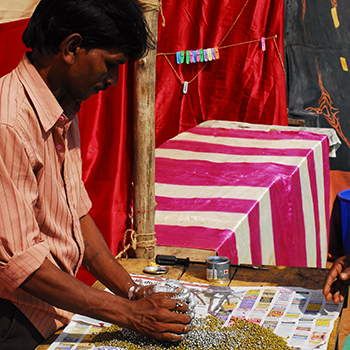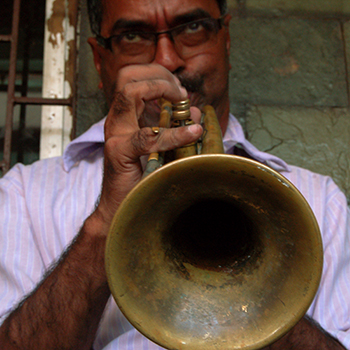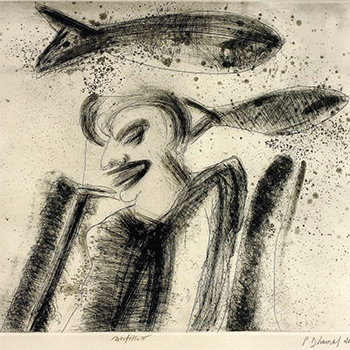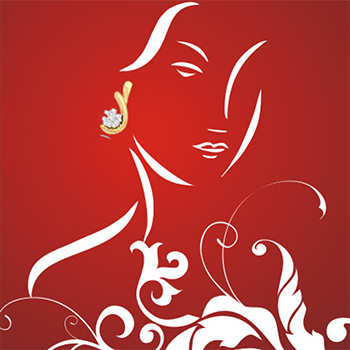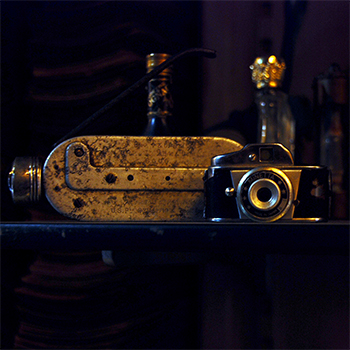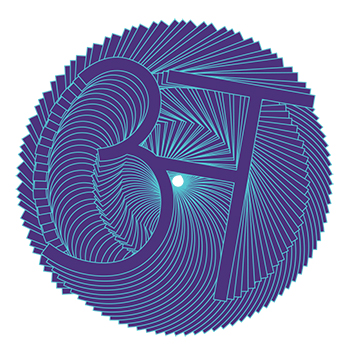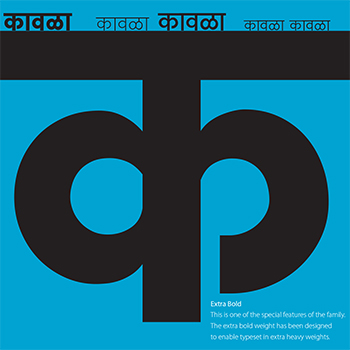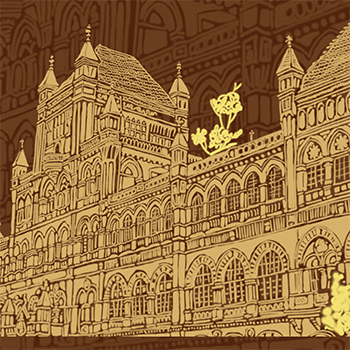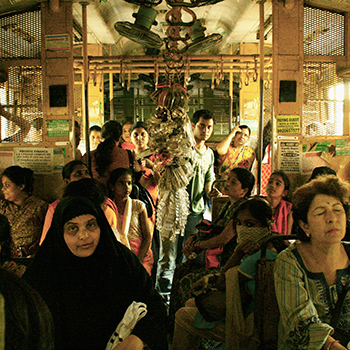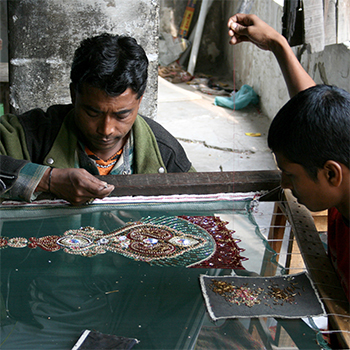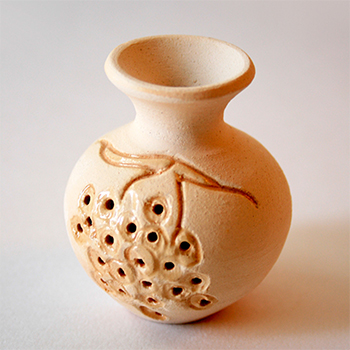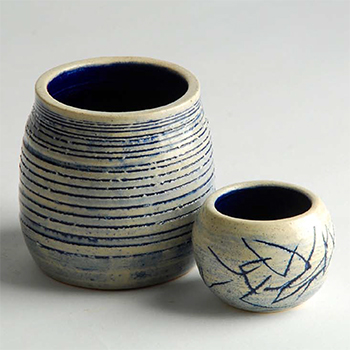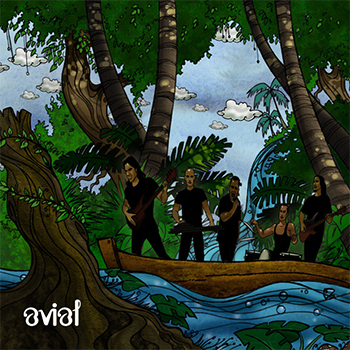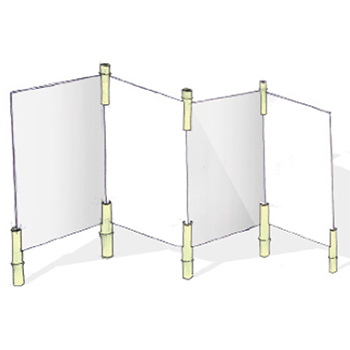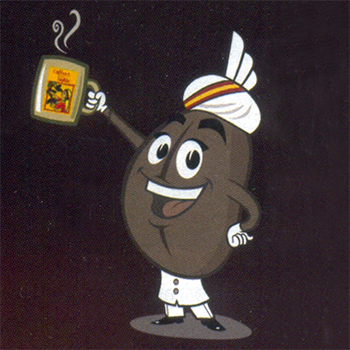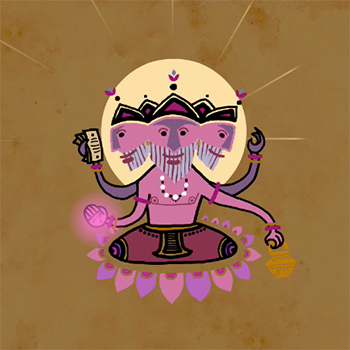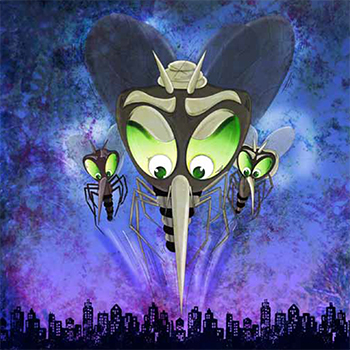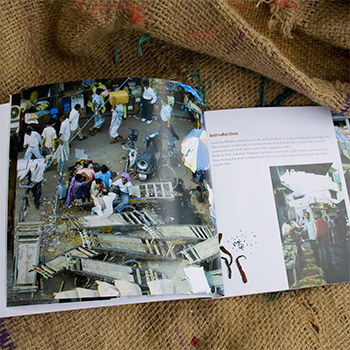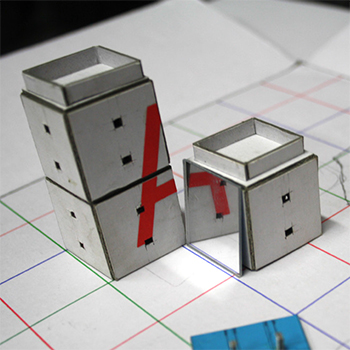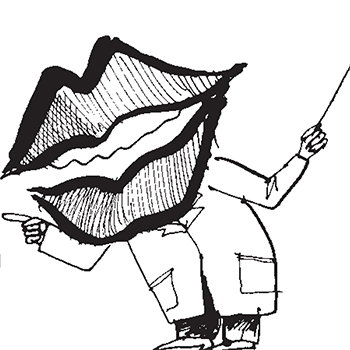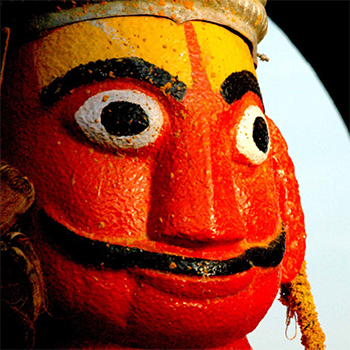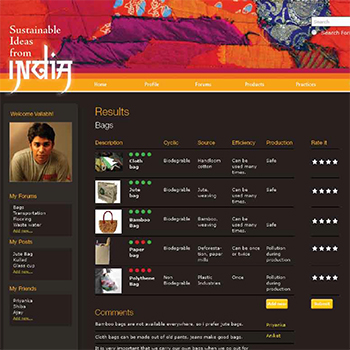Communication Design
Batch 2008-2010
(41 items)
Communication DesignBatch 2008-2010
(41 items)
(41 items)
Folk Culture Of Maharashtra~ East Indians Of Vasai
by Kulkarni Aditi Subram
by Kulkarni Aditi Subram
This project, titled "Visual Dictionary: Folk Culture of Maharashtra", looks at the East Indian community of North Konkan in general and the Samvedi Christians of Vasai Taluka, Thane District in particular. What makes this community remarkable is that it did not evolve thus, naturally, but out of mass religious conversions. Several kingdoms ruled over the Vasai region, each one adding their own flavour to what already existed . Creating a cultural mosaic; a sort of mash-up of languages, music, food, rituals, and costume. Thus, a hybrid folklore has evolved. Today, the youth of Vasai are moving away from traditional jobs and lifestyles. Their urban white-collared jobs have not only brought them prosperity but also the notion that "traditional" is passe while "western" speaks of fine taste. Thus, the rich culture of Vasai stands at a crossroads. Having said that, self-reflexivity compels me to look at myself as I judge Vasaikars for letting their culture evaporate. Don’t most traditional cultures melt into cosmopolitia and die a natural death? So, on what basis should I insist that they preserve their traditions when I myself think in English rather than my mother tongue? This report is an account of journeys made to Vasai villages. It attempts to understand "folklore" and its context by looking at East Indian literature, music, and customs. The Visual Dictionary was done much later, almost as an afterthought. more out of curiosity about the place than as a pre-requisite for this special project.
Details >>Summer Internship at Upasana
by Kulkarni Aditi Subram
by Kulkarni Aditi Subram
Auroville (City of Dawn) is an ‘experimental’ township in Viluppuram district in the state of Tamil Nadu, India near Pondicherry in South India. Auroville is meant to be a universal town where men and women of all countries are able to live in peace and all nationalities. The purpose of Auroville is to realize human unity. Upasana Digital Studio was founded by Uma Prajapati, Upasana was born in 1997, originally with one table under a tree, as a garment design and manufacturing unit. Today it is a place where business, creativity, fashion, Indian Culture, design, social responsibility and spiritual progress all come together for a creative synthesis. Recognising the extensive litter plastic bags throughout India and the damage it was doing to our environment, the team at Upasana Design Studio set about creating a reusable cloth bag that could be conveniently packed and carried, eliminating the need to use plastic. This project aims to tackle large issues with small steps and move towards greater environmental and social awareness.
Details >>Getting people to interact
by Kulkarni Aditi Subram
by Kulkarni Aditi Subram
Modern design education in India began with the setting up of National Institute of Design (NID) in 1961 and Industrial Design Centre (IDC) in 1969. Much has happened since then. From the days of ‘License-Raj’ India has taken a path to liberalisation and opened its markets to the world. In the wake of all this and the shift from a social[1]ist outlook to a more capitalistic inclination, the role played by design schools needs to be reviewed and re-examined. This chapter is related to my readings and reflections on subject of design and design schools. I also look at Auroville (though not a design school) as it has an atmosphere conducive to growth and nourishment for creative spirits. Two other notions that offer interesting standpoints that can enrich educational approaches at IDC are liberal arts and self-reflexivity
Details >>Viju Master (a film on Jaihind Brass Band)
by Kulkarni Aditi Subram
by Kulkarni Aditi Subram
Hopes to open up the world of a brass band owner to everyone and draw one into the culture, traditions, beliefs and aspirations of the Samvedi community to which the musicians belong. This film is about individuals who are musicians by passion and bankers, engineers, teachers etc by profession. This film is really about balancing passion & profession, making life meaningful, giving back to community and about individuals, pushing towards progress and taking everyone along. Jaihind Brass Band plays at weddings, communions etc in Vasai area. My personal journey of getting to know them unfolds through this film.
Details >>Print Making
by Anindita Mandal
by Anindita Mandal
This project is directed to explore the possibilities and future of printmaking and setting up a fully functional printmaking setup in IDC, IIT Bombay in order to enable the enthusiasts to express themselves through the feeling of multitude, the core essence of printmaking. Going by the varieties of the printmaking techniques, the knowledgeble ones know that the technical possibilities are unbounded which includes, but not limited to etchings and woodcuts, vinyl graphics, linocuts, lithographs and complicated, conceptually driven projects intended to raise social consciousness. Philosophical questions remain. As new mediums proliferate and lines between genres dissolve, you may wonder if there is any value in maintaining printmaking as a separate artistic category. To answer this question, it is tried in this project to explore the realm of printmaking, as a separate genre of art and art history, as well as the medium through which the artist can probably vent out her/his long due frustration of unfruitful labor, as printmaking comes with the feeling of giving birth, a feeling of long overdue success, of engraving some permanent mark in the roof of the bulldozer of myriad expressions and tools of creativity.
Details >>Summer Internship at Digital Picasso
by Anindita Mandal
by Anindita Mandal
Digital Picasso has been founded and is headed by Shahid Badshah, a JJ School Graduate with over 9 years’ of design excellence. This is an advertising and brand design agency. They think, They design. They fuse the science of strategy and the art of pixels. They create & offer creative communication solutions. Applying micro-thinking to macro levels. Just by thoughtful design. A small agency with big ideas. They are digitally related to Picasso. They are Digital Picasso. My main task was to re-design logo, back drop,posters, brochure. display design, packaging and survey for Sparkles diamond jewellery and design a brochure for Uniglo diamonds(Belgium). I worked on following topics: • Re-branding for sparkles diamond jewellery • Brochure design for Uniglo diamonds. This was a new apporch for me and was exciting as well as challenging, which allowed me to look at design from industry and user point of view.
Details >>Design for people with Speech and Hearing Disabilities, for Mirakle Courier
by Anindita Mandal
by Anindita Mandal
The aim of this project is to understand the working system of Mirakle Courier and their employees as all the employe’s are speech and hearing disables. The project also aims at understanding the working of courier system and make changes in the existing system to make the work more efficient and fast. The target audience being the employees of mirakle courier, the project aimed at designing a working system for them which will include stationary design, design and redesign of various forms, computer base application etc. Which will make the working system of Mirakle Courier fast and efficient.
Details >>Images Beyond Sight
by Anindita Mandal
by Anindita Mandal
The project is an attempt to understand the possibilities of visual structure and composition of images photographed by the visually impaired. It also tries to understand the uncharacteristic shooting angles in addition to the objects and the subjects they choose to shoot- to open a window to their rich, fantastic visual world. The documentary film explores the various tactile, audio clues, visual memories of sight, the warmth of light and cognitive skills are used by the visually impaired to create “mental image” before they take judgment to take a picture. They use the camera as an extension of “self” to explore the visual world, gain deeper insight while recording their imagination and their point-of-view. Photography by the visually impaired reveals that a photograph can be made successfully in the mind as much as by the eyes, free from the techniques and rules followed by sighted photographers. It illuminates a new line of thought distinct from the way we approach photography and demands active mental participation of the sighted viewers to understand the experience of expressing a world that is not seen or limitedly seen.
Details >>Chor bazaar - we recycle the past
by Kimya Gandhi
by Kimya Gandhi
The methodology of visual research has been challenging for the simple reason that it is difficult to be invisible in an environment and be observant at the same time. Since the most important aspect of visual ethnography is observation, an open mind and eyes are the most important tools while doing research. The stages of research of research have been: General observation and getting to know the place: this included just walking around the bazaar without any particular intention. This establishes a sense of the place and people around. The next stages involved close observation of people, products and shops. This included using media like sketches, notes and photographs to document the bazaar again with no particular focus. This helped lay a ground for study and reflection of the subject area. Once there was an established sense of the place the next stage has been to focus more into a particular area or person, learn and record more insights. The study thus starts from an overview of the bazaar. It then slowly enters a macro level where each aspect of study is carefully understood.
Details >>Devanagari Font Design for OCR at Centre for Development and Advance Computing, (CDAC) Pune
by Kimya Gandhi
by Kimya Gandhi
The project is an attempt of acquainting me to the field of type design and scripts in India. The format of the document is more like my learning diary where I have tried to put together the various facets of type design the way I have learnt them. ‘The process has been equally important to the end product’. The chapters progress in the same order as I have approached my project. The first two chapters speak briefly about the nature of work in CDAC in the field of font design and an account of the project initiated there. In the next two chapters I have tried to summarize very briefly the digitization in letter design pertaining to Indian scripts and standards and the study of devanagari script which is a prerequisite to developing further understanding. The further chapters extensively elaborate my project work and stages involved. It reflects my approach and methodology and the actual learning of the project and process of font design. Thus the document lays down the process of my summer internship, moreover the many various things I got to learn and see during the course of this project.
Details >>Design of a multi-purpose Devanagari typeface
by Kimya Gandhi
by Kimya Gandhi
The increasing advent of globalization and technological advancements are taken to tell that we are living in an age of increasing sameness. The cultural diversity, once rich and abundant is being replaced by a global culture. This has had an effect on the visual culture of India. Regional dialects, languages and scripts have not escaped the consequences of ‘modernization’. The well painted billboards and shop signs have been replaced by massive in your face advertisements. The streets are full of panwalas and departmental stores wear the same huge red beverage advertisements on their heads. The devanagari script saw its peak in the times of letterpress, when elegant complex letterforms were cast and used widely in print and publication. The nature of Indian scripts being different than Roman or Latin, their digitization initially proved to be a tedious task that did not deliver the script in its totality. Recent developments in type digitization however have reached a stage where the script can be produced in its original richness of form and elements. There has been increasing demand for the digitization of Indian scripts to reach larger number of audiences via several media. In the print media, newspapers in Hindi boast more circulation than their english counterparts, proving that there is certainly demand. The digitization of Indian scripts however have brought in their wake alteration in form to suit the requirements of the technology available. Though reach of the scripts has widened, they propagated the spread of a deteriorated form. This forms the inspiration for undertaking the task to analyze the current type design scenario & thereafter design a new approach to designing typefaces to propagate the richness of a correct and complete script.
Details >>Design of a Multipurpose Devanagari Typeface
by Kimya Gandhi
by Kimya Gandhi
The devanagari script saw its peak in the times of letterpress, when elegant complex letterforms were cast and used widely in print and publication. The nature of Indian scripts being different than Roman or Latin, their digitization initially proved to be a tedious task that did not deliver the script in its totality. Recent developments in type digitization, open type font formats, web embedding has ensured the script to be produced in its original richness of form and elements. There has been increasing demand for the digitization of Indian scripts to reach larger number of audiences via several media.
Details >>Study of Marathi Literature for Children
by Maitreyee Sanjay Nilawar
by Maitreyee Sanjay Nilawar
This is a study of Marathi literature for children written in Devnagri script. I did a study of the technicalities of Marathi books from the point of view of illustrations, printing quality, layouts, and content. I have interviewed several authors, illustrators, publishers, school teachers, shopkeepers, and kids. I have done a comparative study of the present material available in the market and the older literature. The past and current trends in reading have been analyzed. The methods which can be employed to increase interest in reading Marathi books have been included in this project.
Details >>Summer Internship at Synapse
by Maitreyee Sanjay Nilawar
by Maitreyee Sanjay Nilawar
Synapse is an information agency that partners with clients to solve their business problems through information based initiatives. t the process of interacting with clients and delivery of work because unless we stand for something, how we will work. There are almost 40 people work there in different project group. The family members of Synapse are Visual juju, txtcontxt, dotahead, Zaki etc.. So there are like 8 sections. Which works unitedly and happily under one roof. In main Synapse office according to clients the project sections are divided, like Zaki works on creating paintings as they supply paintings as per the order. I was appointed in Project 3 where mainly they were working on HP printers, Microsoft, and Share Khan. For HP printers, the task was to create sale in electronic shop where other gadgets are available. We had to create idea for need of printers so that its selling rate increases and the market for printers rises. In the other projects of Microsoft and Share Khan I had to create comic illustration for their home purposes which were used within the office.
Details >>Visual Guide for FORT area Mumbai
by Maitreyee Sanjay Nilawar
by Maitreyee Sanjay Nilawar
Fort is the business district of Mumbai. Once considered the heart of the city, this area is known for its side walks those are constantly filled with vendors selling books, music cassettes, CD, clothes, imported items etc. This area is also gifted with other gems include Bombay University, The High Court, the BMC Building and stately Horniman Circle. This area is jam-packed with visitors and commuters who came to experience this established commercial center of Mumbai. In addition of my personal experience of finding way to my desired destination had a dependency on street vendors and local people. I also found many other people like face similar problems and it was much greater for people from foreign land due to language barrier. I decided to work in this particular area in order to help the visitors to reach their desired destinations and also arouse my interest as a Visual Designer to take up this problem of helping tourists to explore this area by providing them with a visual Map.
Details >>Reflections of Nature in Imagery
by Maitreyee Sanjay Nilawar
by Maitreyee Sanjay Nilawar
The project is an attempt to understand my approach to painting. It began with a study of my earlier works that included textile motifs using forms from nature. During the project I explored using acrylic colours and creating images that were not entirely pre-meditated. As a painter to expresses his/her thoughts through paintings. As being a student on visual arts I was able to express myself through my paintings but it was very tough job writing about it. There may be many flaws in my writings. I am used to creating images from early times and I am confident of expressing it well but my writing, which I started few months back is not that good. So I have written this report in an question answer format, the question which I had asked during the process, so I feel that this process will be easy to understand for the reader to grasp.
Details >>Visual Ethnography of a Mumbai Local Train
by Radhika Gujar
by Radhika Gujar
This is a document of what I have seen, experienced and heard when I traveled on the No. 9 compartment of the Mumbai Local trains. There are many things about the Locals that surprise me every time I travel in one. There are so many interesting people that you meet in the compartment. They are friends who meet only in the locals, who share their lives for the time they travel together and then go their own way. There are many incidents that made me want to do visual ethnography such as experiencing a “bhajan” group (groups which sing religious songs) in a men’s compartment, hearing of groups of men who meet on the same local everyday so as to play cards, Women who have formed groups in the train and have kitty parties which are named after the time or number of the local trains etc. I wanted to see this different world and experience every bit of it. When I started going by train I realised that it was too vast a subject to cover so I started concentrating on the women’s compartment only and that’s when I realised that its a small world in itself and had many kinds of incidents that I could write on.
Details >>Redesign of Magazine, Brochure and Design of Newsletter for Maharogi Seva Samiti
by Radhika Gujar
by Radhika Gujar
In the year 1949, the great humanitarian Baba Amte being moved to the core by the physical trauma and social stigma of leprosy afflicted people, set up the Maharogi Sewa Samiti on a piece of 50 acres of uninhabited, barren and rocky land in Warora, Chandrapur District, Maharashtra. The initially the activities were limited to the medical treatment, training and rehabilitation of the leprosy stricken. However, due to the unique nature of services rendered, over the years, it grew to such heights as to embrace within its ambit a wide spectrum of downtrodden and marginalized people as the physically challenged, the deaf-mute, the blind, orphans, tribal people etc. Muralidhar Devidas Amte was born at Hinganghat in Central India, on the 26th of December 1914. As the eldest son of a wealthy Brahmin landowner, Muralidhar was protected from any material deprivation. His enormous energy was happily absorbed in an idyllic childhood with long hours of play, pranks and wrestling with other boys.
Details >>Exploration in Tangible Storytelling
by Radhika Gujar
by Radhika Gujar
Storytelling or the verbal narration is an art that makes stories more immediate. Storytelling is an oral tradition. It is known to use several media such as painted scrolls etc. to enhance the telling. However the control still stays with the teller. I wanted to add one more dimension to the already existing art of storytelling i.e. to make it more tangible in the physical sense of the word and a personal experience. I also wanted to let the child learn storytelling and use the same tangible characters to create multiple narratives. Stories and Storytelling have always fascinated me. As a child I always loved to listen to various stories told by my grandmother and my mother. Also I used to love making up stories with the innumerable toys that I had. Remembering my days of wild imagination I wanted to create a similar platform for children that could allow their thoughts and imagination to be free.
Details >>Exploring innovative approaches and techniques in Macro Photography
by Radhika Gujar
by Radhika Gujar
“Exploring innovative approaches and techniques in Macro Photography” is a project in which I will be exploring and learning the different facets of macro photography. I will be exploring techniques used to do macro photography and present the images in a novel way. In doing so I will increase my knowledge and enhance my skills of macro photography. At a later stage I will be combining Macro photography techniques with time lapse photography to give the project a whole new dimension.
Details >>Zardozi Stitches of Lucknow
by Sakshi Gambhir
by Sakshi Gambhir
Lucknow has been famous for its various handicrafts for as long as anyone can remember. Zardozi is one of the most exquisite ones. It is extensively practised in Old Lucknow where a lot of craftsmen live and work. I visited one of the add as where it is done and in no time made a bond with them. This project is an attempt to understand the nuances of the craft and its people, get a glimpse of their life and know them better. Each day marks a different experience, a stronger bond and a deeper layer of insight. In the course of this visual ethnographic study, I begin to enjoy the rhythm of everyday activities and evolve in a way that is intangible.
Details >>Studio Pottery
by Sakshi Gambhir
by Sakshi Gambhir
“Pottery is not just an art form, it is a therapy.” An AIFACS awardee, Meena Vohra believes “Its never too late to learn.” She had her first brush with clay at the age of 50. She has had a journey through its realms and has carved a niche for herself. She had been a school teacher for 13 years but was always interested in art. Pottery is made by forming a clay body into objects of a required shape and heating them to high temperatures in a kiln to induce reactions that lead to permanent changes, including increasing their strength, hardening and setting their shape.
Details >>Conversations with Clay
by Sakshi Gambhir
by Sakshi Gambhir
I love clay. In it I feel seeds of growth that I can nurture with my hands. Pots are like babies and pottery a bliss. Every pot is a projection of myself but it has a language that is beyond the grammar of written words. It is like a conversation that happens between clay and fingers, the former almost commanding the latter how to move in a certain rhythm and create the form. It is challenging yet simple, it is primordial yet playful, it is formless but creates the form and it is full of surprises. Goals for the current project: * To demonstrate the ability to create a set of identical pots to the extent to which the effortless ease of production pottery has been internalized. * To evolve my own aesthetics of form and glazing. * To develop a clarity with regards to repositioning of a craft. * To explore pot-making. * To follow the bliss.
Details >>Exploring Alternatives in Education
by Sakshi Gambhir
by Sakshi Gambhir
People across the globe are bothered about the future of the planet, a future that none of us have any answers to. With a hope that the generations to come will save the world, both outside them and within, alternate and non-traditional models of education have to be explored. A holistic education of the child is necessary to find an answer to that question. That is what sketches the outline of my project this semester. Goals for the current project: * To attempt an understanding of how children behave in a given environment. * To observe their responses to materials and learning through art. * To document the Free Progress education model followed in Deepanam School, Auroville, in the form of a book. * To explore book-design.
Details >>Understanding the philosophy of Contemporary Indian Rock Bands through their Visual Representation
by Saurabh Tewari
by Saurabh Tewari
Indian music and visual communication has developed through ages. It always incorporated western and technological influences to create new forms. Similarly, with the rise of information technology and knowledge sharing at the speed of lightening, the new forms are emerging. The idea is to look into the mentioned fields in the present scenario, cumulatively and then simultaneously. The contemporary music scene in India is an ocean itself. The rock music has also found its way and scope within a larger domain of “music from India”. The musicians are attempting to communicate not just musically but also visually. So, the research attempts to understand the philosophy of contemporary Indian Rock Bands through their Visual Identity and Representations.
Details >>Industry Internship Report
by Saurabh Tewari
by Saurabh Tewari
The UNESCO New Delhi Office’ Social and Human Sciences Sector has commissioned an Indian adaptation of the generic Guide, Historic Districts for All – a Social and Human approach for Urban Actors The generic guide is the result of the work carried out at UNESCO between 1997 and 2007 and has been produced as a teaching tool to address the pressing need of local decision makers in large and medium sized cities, and to strengthen the capacities of city professionals, architects and urban planners across the world. Considering the specifity of the Indian Urban context, UNESCO has decided to develop a Guide for Urban Actors in India that reflects the country’s complex urban scenarios, the structure of local governance, the decision making chain and the urban reform currently underway through the Jawaharlal Nehru National Urban Renewal Mission ( JNNURM). An official interview was taken on 7th May 2009 by Ms. Marina Faetanini, Programme Specialist , Social and Human Sciences Sector. A Current Project, Historic District for All – India, was explained by her. After learning the internship duration is just a month, she insisted that I should stay at the organization as much as possible. A City Walk invitation by a private NGO, Salaam Baalak, to slums and grey areas near the New Delhi Railway Station was an eye opener. The Constraints in which people live and their will not just to survive but also to excel was inspiring. This City Walk had a different flavour to offer from the Traditional Heritage City Walks in different cities around the World.
Details >>A travelling exhibition on Laurie Baker, the architect, his works and philosophy
by Saurabh Tewari
by Saurabh Tewari
Today, when the western images dominate design and architecture students’ minds, they become disassociated with indigenous practices. With a jargonized consciousness around, the inspirations need to come from the self. Especially, when there is a wave of sustainability in design environment, and complex facial approaches towards it, there is a need to come up with relevant and simple methods. Architect Laurie Baker’s work lies in the relevant domain of indigenous geniuses. His wide variety of works handled with not so common ‘common sense’ is boon for this century. Being an architecture and design student, I always heard and acknowledged Laurie Baker’s work, but never realised the strength of his way of building, which lie in the power of simplicity. So, I see this project as an opportunity to present, to our generation, a relevant philosophy towards design and life.
Details >>Design for Elderly: Mitrika, a hindi magazine
by Saurabh Tewari
by Saurabh Tewari
Being old is a tough truth of life. It is inevitable. One cannot avoid it, but one can definitely live it! The silvering of life can make people lose their contact with their internal and external world, as there is a gradual deterioration in the mind-body coordination. The physiological strength declines with time, which most of the times effects the overall psychology and vice-versa. Whereas, if one attempts to keep the mind engaged in creative pursuits, the deteriorating nature can be neutralized. A good mind, therefore can help in maintaining a good physique. Eventually, the state of wellbeing is the most important factor towards, living it! When in my first year of studies, the project “Design for Elderly” was introduced, I had hazy ideas about the approaches towards the subject. I was not clear how will I really contribute. With time as I discovered the general process of user specific design, I realised one can really attempt towards designing for this newly emerging segment. Initially, I was trying to relate only with physiological problems. Later, I realized my scope of work is more toward the psychological aspect. The boundaries are thin, and one needs to walk over them cautiously. One really needs to understand, what this user group really would like to have. Not a radical change, which makes the benefits them to a level of isolation, and not the same pulp which makes them struggle for finding the context and association. Just a balance, a design, which makes them feel special.
Details >>Summer Internship project at Lotus Concepts
by Sheetal Vishwas Barge
by Sheetal Vishwas Barge
In the Summer Internship project in Lotus, I got opportunity to work on ACEAGRO project under Omkar Mulgund. It is an India based Agricultural company which is famous for its export quality organic products. There were different projects executed by me as a part of this training which ranged from CIP (Corporate identity programme) for Natural Sweetener which is Aceagro’s total organic substitution for sugar, Cat[1]egorization of Information and designing for web designing and Informative show reel of company for Aceagro. While working in summer internship project I learnt other related areas of design such as handling corporate clients and their comments, and giving my best in deadlines.
Details >>Exploration in story telling using Mythology to address contemporary issues
by Sheetal Vishwas Barge
by Sheetal Vishwas Barge
The earth has its own system of balancing its environment. The cycle of balance is going on from so many years. Now this cyclic process of balancing is facing numerous problems. These problems are slowly affecting the whole planet and ultimately, us. There are many organizations working on environmental issues to spread this awareness. This message needs to reach to every level, so the needed change in human behavior and habits can be motivated. In India where not everyone is literate and not everyone has access to technology, this message need to find its way to all. I am trying to convey this concern for environment in a manner, which is highly accessible though simplified. For this purpose, I am working on a theme, which is close to a large part of Indian society, who can easily relate to the way it is made. I am using a traditional way of entertainment, education and communication to convey my thoughts about environment, which is mythology.
Details >>Documentary film on Cartoonist and illustrator S. D. PHADNIS
by Sheetal Vishwas Barge
by Sheetal Vishwas Barge
Mr. S. D. Phadnis is a renowned cartoonist and an illustrator, working for almost six decades. He has carved a niche for himself in the field of humorous illustrations. The simplicity in his work brings out the humor in the day-to-day life. His outstanding illustrations in the Maths textbooks (1st/2nd std) for school children, introduced me to the splendid art of illustrations at a very early age. His illustrations made learning Maths more fun and easy. Thanks to my documentary film project, for my Masters, I got an opportunity to meet him personally and understand his perspective towards work.
Details >>Bicycle Friendly Area Design Workshop
by Shiba Sheikh
by Shiba Sheikh
Auroville is meant to be a universal town where men and women of all countries are able to live in peace and progressive harmony, above all creeds, all politics and all nationalities. The purpose of Auroville is to realize human unity. It was founded in 1968 by Mirra Richard (since her definitive settling in India called “(The) Mother”) and designed by archi[1]tect Roger Anger. Auroville was founded as a project of Sri Aurobindo Society on Wednesday 28 February,1968 by The Mother. She was an equal spiritual col[1]laborator of Sri Aurobindo, who believed that “man is a transitional being”. The Mother expected that this experimental “universal township” would contribute significantly in the “progress of humanity towards its splendid future by bringing together people of goodwill and aspira[1]tion for a better world.” The Mother also believed that such a universal township will contribute decisively to the Indian renaissance. The aim of Bicycle Friendly Area design workshop was to research, conceptual[1]ize and prototype a few components of environment (pathways, shelters, lighting, signage and accessories) using local and natural materials to create new forms with minimal eco footprint.
Details >>Chai Conversations
by Shiba Sheikh
by Shiba Sheikh
Chai is merely the generic word for tea in Hindi and many other languages around the world, but for many English speakers outside those regions, particularly in the Western hemisphere, “chai” automatically implies “masala chai”. The traditional chai-brewing process actively boils the tea leaves over sustained heat. Chai prepared in this manner has a caffeine level higher than most teas, as the prolonged boiling produces a more robust beverage than quiescently steeping the tea leaves in hot (but not boiling) water. Chai has no rules. You can make it the way you like. Drink it the way you like. Hey, even drink it whenever you like. It’s got no stiff upper lip rituals and spares you the embarrassment of not knowing the difference between a mocha and a macchiato. It’s no wonder then that this quaint, traditional Indian concoction has evolved from a common man’s beverage to a whole new way of life for today’s young and old. The flavour of chai may change from one region to another, but the ease at which it brings people together never will.
Details >>Diseases, Prevention & Control Reference book on Malaria for children
by Shiba Sheikh
by Shiba Sheikh
A book on Malaria for children from 7 years and above. It is placed in the young reference book category as it provides factual content in an engaging, creative & coherent form. The stem of the book is a story based on the disease which takes forth the content explaining the all key components involved in understanding & learning about a disease, control & prevention. The story is only to help children make associations , relate with characters & follow a time line, while the essential facts and information to give deeper in-depth understanding of the science behind it.
Details >>Internship in Photography with Ravi Dhingra, New Delhi
by Jampala N Somya
by Jampala N Somya
This was an opportunity to experience documentary photography. I wanted to attempt at the procedure of ideation, creation, execution and production during my internship. Hence, I intended to learn the process of design with photography as the medium while I interacted, observed and received feedback from different people and photographer Ravi Dhingra. Knowing my interest, he encouraged me to take up a project on my own giving me complete freedom. As I learnt and understood the various techniques from him, I also developed my own rules towards photography and completion of a project. Ravi Dhingra is an established freelance photographer based in New Delhi with an experience of more than 10 years in Lifestyle Photography which includes Food, Interiors, Product and People. Besides working for leading Advertising Agencies in India, he is also associated with Fine Dining Restaurants for Food and Interiors photography. He has been teaching at NIFT, Delhi since many years. I started understanding basic features of using a digital SLR moving on to learnt some helpful thoughts I should consider while pursuing photography. The learning was based on discussions regarding elements in a photograph, foreground & background and sun, lighting & shadows. Considering my interest in travel photography, I was encouraged to go to the streets of Chandni Chowk. The various activities in Chandni Chowk made me absorb myself in the environment and take up a subject for a project in the area.
Details >>Playful learning for children in Indian context
by Jampala N Somya
by Jampala N Somya
Science is all around us. Everyone enjoys the pleasure of learning about universe and tries to understand it. But, children have an inborn curiosity and yearning to make sense of things, people and the world around them. Play is a voluntary intrinsically motivated activity being associated with pleasure and enjoyment and It presents the best answer towards learning in for children. The project is an attempt to facilitate playful learning for children of 11-14years of age which can be adapted to different learning environments of Indian context. It has been built on a conceptual framework of children, play and learning. It has explored how an activity can be planned and designed for the learning of a child without a textbook and without one to all teaching method. Emphasis is to enable experimentation and creation by children themselves rather than just communication and passiveness towards knowledge. It aims at a solution in the form of an activity kit to enhance sensitivity in realm of light (with reflections and shadows) as well as physical, social, emotional and intellectual development of a child.
Details >>Learning Science through play
by Jampala N Somya
by Jampala N Somya
Learning is associated with education which stresses on learning through classrooms, teachers, text books and exams. But, we tend to ignore the fact that we all including children learn through what we experience. This project aims at selfdirected, purposeful and meaningful experiences against passive, forceful and fearful education. Experiences mean things done with body, muscles, hands, tools as well as the mind; the things which involve actions which are physical and involve senses. Talking, reading, listening, writing, questioning, observing, thinking, making, breaking and even dreaming are part of the experiences. ‘Play’ is the most active component of things when we engage, enjoy, have fun, question, analyze, argue, prove and do things. Science is to know how things work. Children are naturally curious to know how things work around them. Sun is the most essential component of our existence being responsible for most of the phenomena in our environment. It is important to know Science behind Sun. The project is an attempt towards learning to understand ‘Sun’ through a book where activities are planned and illustrated to encourage children to learn Science with readily available materials in a playful way.
Details >>Visual Ethnography at Jejuri
by Vallabh Prasad Munshi
by Vallabh Prasad Munshi
In India, the religion is an inherited pattern, and it becomes a part of a man’s space, time and soul. Religion has the most fascinating things to offer, to name a few are food, festivals, clothes, language and even scripts. Pilgrimage destinations have the most intriguing faces, faith is the driving force and people seem to have a strong belief that supernatural powers actually control their destinies. An observation is that the people who have a rationale in their daily lives become either eccentric or naive while on a pilgrimage. Suddenly, god becomes the objective and priests become the bosses, nothing else matters. Man is ready to stretch himself to limits for a simple darshan or a ceremony in the temple.
Details >>Summer Internship at Mtv
by Vallabh Prasad Munshi
by Vallabh Prasad Munshi
It is an Ident for Mtv. In this proect I could work on a script of my own and get a budget sanctioned for the film. I proposed a stop-motion animation for the same Mtv requires idents for itself which are aired, they act as fillers and also promote the channel. With the monsoon knocking at the doors i thought of doing a film which gives a feel of monsoon. It did not have a story as such but just a crazy sequence of some sort. The initial script was a morph of visuals seen in the monsoon season, i intended to depict the relief brought to man by monsoon. The idea was rejected because they had already done a lot of morph animations in the past and so had other music channels. I explored the possibility of a man who was being prepared for the monsoon by a pair of scissors. This script was finalized and a ten second Ident for Mtv was proposed.
Details >>Forum for Sustainable Ideas from India
by Vallabh Prasad Munshi
by Vallabh Prasad Munshi
“Development that meets the needs of the present without compromising the ability of future generations to meet their own needs”.[1] Sustainable development is defined as a pattern of social and structured economic transformations which optimizes the economic and societal benefits available in the present, without jeopardizing the likely potential for similar benefits in the future. A primary goal of sustainable development is to achieve a reasonable and equitably distributed level of economic well-being that can be perpetuated continually for many human generations. Sustainable development implies using renewable natural resources in a manner which does not eliminate or degrade them, or otherwise diminish their usefulness for future generations. It further implies using non-renewable or exhaustible mineral resources in a manner which does not unnecessarily preclude easy access to them by future generations. Sustainable development also requires depleting non-renewable energy resources at a slow enough rate so as to ensure the high probability of an orderly society transition to renewable energy sources.[2] Sustainability has become such a wide-ranging term that it can be applied to almost every facet of life on Earth, from a local to a global scale and over various time periods. This is not about obvious things like recycled paper or electric cars. We must expand our horizons and start looking at everything around us.
Details >>Signage & Wayfinding design for Maharashtra State Road Transport Corporation
by Vallabh Prasad Munshi
by Vallabh Prasad Munshi
In an ideal world, there is very little that needs to be told about where to go, because on arriv[1]ing at an unfamiliar destination, the next direction would be self-evident. Within the best architecture, finding ones way around should hopefully require minimal effort and, at least, minimal signage.1 This implies that design, which has a holistic approach and which is centred around the users takes care of most of the problems, including wayfinding. In a situation like Maharashtra State Road Transport Corporation (msrtc) popularly known asst, it is apparent that planners, architects and designers are not being consulted. The admin[1]istration seems to be ignorant to the fact that designed interventions prove to be efficient and economical in the long run. Msrtc is trying to update itself in a lot of areas by incorporating electronic tickets, computer[1]ised reservations, air-conditioned buses etc. It keeps on adding more and more buses to its fleet and it reaches out to citizens living in the remotest areas of Maharashtra. But, the problem in the current system is that it lacks functional foresight. The system starts loosing its integrity whenever there are additions and alterations. These changes should be anticipated in advance because they are natural, especially in an increasing population like ours which has increasing demands every day. To cater to these demands there are make-do arrangements and casual signages which are inefficient, as a consequence, chaos prevails at all times. Due to inadequate planning and casual methods, there are loopholes in the communica[1]tion system, due to which information is not understood and then there are further problems. Things become even more confusing during rush hours. Buses arrive and depart continuously and anxious people are seen pacing around all the time. The staff is overburdened due to the immense number of passengers who keep on inquiring at the counter. The regular passengers become immune to the system because of the routine, but they still deserve better service. Among all, the people who suffer the most are the novice, elderly, non-marathi speaking citi[1]zens, handicapped, illiterate, women etc children.
Details >>